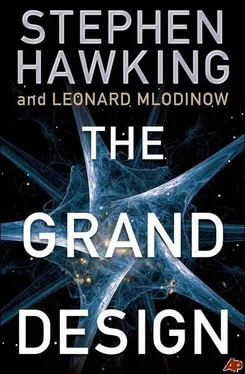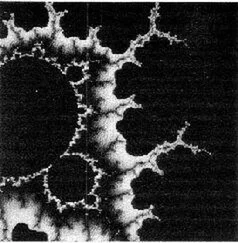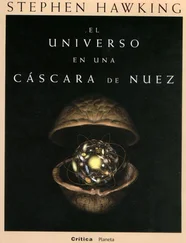Though realism may be a tempting viewpoint, as we’ll see later, what we know about modern physics makes it a difficult one to defend. For example, according to the principles of quantum physics, which is an accurate description of nature, a particle has neither a definite position nor a definite velocity unless and until those quantities are measured by an observer. It is therefore not correct to say that a measurement gives a certain result because the quantity being measured had that value at the time of the measurement. In fact, in some cases individual objects don’t even have an independent existence but rather exist only as part of an ensemble of many. And if a theory called the holographic principle proves correct, we and our four-dimensional world may be shadows on the boundary of a larger, five-dimensional space-time. In that case, our status in the universe is analogous to that of the goldfish.
Strict realists often argue that the proof that scientific theories represent reality lies in their success. But different theories can successfully describe the same phenomenon through disparate conceptual frameworks. In fact, many scientific theories that had proven successful were later replaced by other, equally successful theories based on wholly new concepts of reality.
Traditionally those who didn’t accept realism have been called anti-realists. Anti-realists suppose a distinction between empirical knowledge and theoretical knowledge. They typically argue that observation and experiment are meaningful but that theories are no more than useful instruments that do not embody any deeper truths underlying the observed phenomena. Some anti-realists have even wanted to restrict science to things that can be observed. For that reason, many in the nineteenth century rejected the idea of atoms on the grounds that we would never see one. George Berkeley (1685-1753) even went as far as to say that nothing exists except the mind and its ideas. When a friend remarked to English author and lexicographer Dr. Samuel Johnson (1709-1784) that Berkeley’s claim could not possibly be refuted, Johnson is said to have responded by walking over to a large stone, kicking it, and proclaiming, “I refute it thus.” Of course the pain Dr. Johnson experienced in his foot was also an idea in his mind, so he wasn’t really refuting Berkeley’s ideas. But his act did illustrate the view of philosopher David Hume (1711-1776), who wrote that although we have no rational grounds for believing in an objective reality, we also have no choice but to act as if it is true.
Model-dependent realism short-circuits all this argument and discussion between the realist and anti-realist schools of thought.
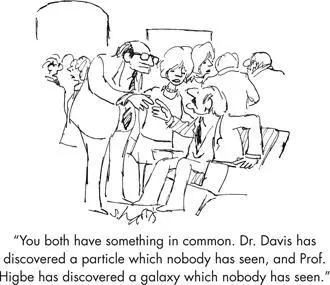
According to model-dependent realism, it is pointless to ask whether a model is real, only whether it agrees with observation. If there are two models that both agree with observation, like the goldfish’s picture and ours, then one cannot say that one is more real than another. One can use whichever model is more convenient in the situation under consideration. For example, if one were inside the bowl, the goldfish’s picture would be useful, but for those outside, it would be very awkward to describe events from a distant galaxy in the frame of a bowl on earth, especially because the bowl would be moving as the earth orbits the sun and spins on its axis.
We make models in science, but we also make them in everyday life. Model-dependent realism applies not only to scientific models but also to the conscious and subconscious mental models we all create in order to interpret and understand the everyday world. There is no way to remove the observer-us-from our perception of the world, which is created through our sensory processing and through the way we think and reason. Our perception-and hence the observations upon which our theories are based-is not direct, but rather is shaped by a kind of lens, the interpretive structure of our human brains.
Model-dependent realism corresponds to the way we perceive objects. In vision, one’s brain receives a series of signals down the optic nerve. Those signals do not constitute the sort of image you would accept on your television. There is a blind spot where the optic nerve attaches to the retina, and the only part of your field of vision with good resolution is a narrow area of about 1 degree of visual angle around the retina’s center, an area the width of your thumb when held at arm’s length. And so the raw data sent to the brain are like a badly pixilated picture with a hole in it. Fortunately, the human brain processes that data, combining the input from both eyes, filling in gaps on the assumption that the visual properties of neighboring locations are similar and interpolating. Moreover, it reads a two-dimensional array of data from the retina and creates from it the impression of three-dimensional space. The brain, in other words, builds a mental picture or model.
The brain is so good at model building that if people are fitted with glasses that turn the images in their eyes upside down, their brains, after a time, change the model so that they again see things the right way up. If the glasses are then removed, they see the world upside down for a while, then again adapt. This shows that what one means when one says “I see a chair” is merely that one has used the light scattered by the chair to build a mental image or model of the chair. If the model is upside down, with luck one’s brain will correct it before one tries to sit on the chair.
Another problem that model-dependent realism solves, or at least avoids, is the meaning of existence. How do I know that a table still exists if I go out of the room and can’t see it? What does it mean to say that things we can’t see, such as electrons or quarks-the particles that are said to make up the proton and neutron-exist? One could have a model in which the table disappears when I leave the room and reappears in the same position when I come back, but that would be awkward, and what if something happened when I was out, like the ceiling falling in? How, under the table-disappears-when-I-leave-the-room model, could I account for the fact that the next time I enter, the table reappears broken, under the debris of the ceiling? The model in which the table stays put is much simpler and agrees with observation. That is all one can ask.
In the case of subatomic particles that we can’t see, electrons are a useful model that explains observations like tracks in a cloud chamber and the spots of light on a television tube, as well as many other phenomena. It is said that the electron was discovered in 1897 by British physicist J. J. Thomson at the Cavendish Laboratory at Cambridge University. He was experimenting with currents of electricity inside empty glass tubes, a phenomenon known as cathode rays. His experiments led him to the bold conclusion that the mysterious rays were composed of minuscule “corpuscles” that were material constituents of atoms, which were then thought to be the indivisible fundamental unit of matter. Thomson did not “see” an electron, nor was his speculation directly or unambiguously demonstrated by his experiments. But the model has proved crucial in applications from fundamental science to engineering, and today all physicists believe in electrons, even though you cannot see them.
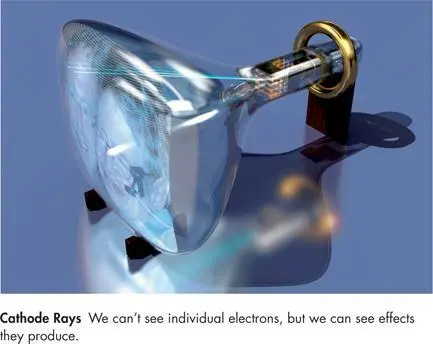
Quarks, which we also cannot see, are a model to explain the properties of the protons and neutrons in the nucleus of an atom. Though protons and neutrons are said to be made of quarks, we will never observe a quark because the binding force between quarks increases with separation, and hence isolated, free quarks cannot exist in nature. Instead, they always occur in groups of three (protons and neutrons), or in pairings of a quark and an anti-quark (pi mesons), and behave as if they were joined by rubber bands.
Читать дальше
